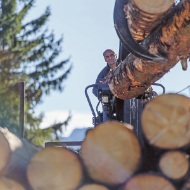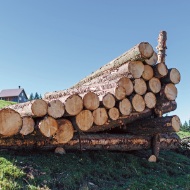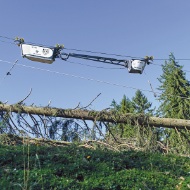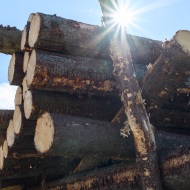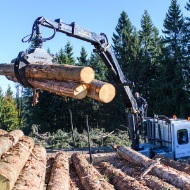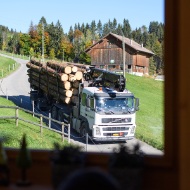From the forest to the sawmill
A conversation with Roger Wegmüller, log purchasing

Roger, Lehmann Holzwerk AG requires enormous quantities of wood. How do you manage to procure enough wood throughout the year?
From a whole-year perspective, the planning works well. The difficulty is more that we need wood every day and the timber quantities depend on weather and other environmental factors. So we have to be able to deal with fluctuations. For instance, if the bark beetles are active in the summer or we have heavy storms in autumn. If it rains for any length of time, the timber can’t be extracted because the ground is too saturated. Such factors have an immediate impact on the available quantity of wood and present a daily challenge.
How do you deal with this constantly changing timber availability?
When I took over responsibility for all log purchasing a few years ago, the situation in the forestry industry was very precarious. Procuring the required quantity of logs was anything but easy. We had to have logs from Chur shipped to Gossau by train. That resulted in high transport costs. So I worked on enhancing our purchasing system and expanded our network of wood suppliers. I now keep in constant contact with our partners and define the weekly delivery quantities.
«Beyond its function as a material, I am interested in the entire value creation chain that surrounds wood. We are part of a sensitive system. The cycle only works if we all approach each other in a spirit of mutual consideration.»

Story
About 25 lorry loads of logs arrive at the sawmill at Erlenhof every day. These log deliveries are organised, directed and coordinated by Roger Wegmüller. He ensures that the right wood of the right quality and in sufficient quantities is always available at Lehmann Holzwerk. At a meeting with log suppliers, he talks about his responsibilities and the future of Swiss wood.
What wood do you purchase mainly and from which regions?
Ideally, I would love to source all our wood from the forests around our mill. But that’s not enough to cover our needs. We require roughly 120,000 cubic metres of wood a year. So I purchase logs primarily from eastern Switzerland and about 10% from southern Germany and Vorarlberg. I need the wood from abroad mainly because we have to be supplied with logs during the summer months as well. For our projects, we use mainly softwood timber; spruce and fir.
Your responsibilities extend well beyond purchasing wood, then?
One might say that I’m responsible for the entire field of log purchasing. The job also involves the organisation of the logistics and invoicing, which we do on a fortnightly basis. I’m also involved in various projects aimed at fostering the continued development of the company. For example, we’re currently working on various development projects in terms of timber processing. That gives me the opportunity to bring in the skills I gained in previous positions with other wood processing operations.

So you’ve been working in wood processing for some time now?
Yes, quite a long while. After my carpentry apprenticeship, I completed my training as a technician at the specialist timber institute in Biel. After that, I managed various production facilities in the timber industry and ultimately took over as head of log purchasing at Lehmann Holzwerk.
What does wood mean to you as a material?
I have always loved wood. Beyond its function as a material, I am interested in the entire value creation chain that surrounds wood. We are part of a sensitive system. The cycle only works if we all approach each other in a spirit of mutual consideration. I also always see that when I’m in our forests as a hunter.
That brings up the Woodvetia Initiative, which the Lehmann Group took an active role in shaping on the Swiss wood days. What is that about?
The Woodvetia Initiative is the campaign for the use of more Swiss wood and aims to promote Swiss wood directly to end consumers. But there’s more to it as well: the forested area in Switzerland is growing each year and yet the use of Swiss forests is in decline. But since the demand for wood is rising, the Swiss timber industry – i.e. traders and wood workers – import a lot of wood and wood materials from abroad. We have to change that.
What measures would strengthen the Swiss timber industry?
Raising awareness among end consumers is certainly a good starting point. But beyond that, we also have to do a much better job of emphasising the benefits and the economic aspect of Swiss wood.

Benedikt Dörig, Forest team Haslen
«For the timber industry and the forestry industry, and thus for Swiss value creation overall, it is important that the forests are actively managed and rejuvenated. Many jobs are associated with that, incidentally. We need innovative ideas. One example would be for us as forestry companies to actively approach forest owners and manage their stands of timber. The forest has various functions; it’s not just a place for recreation or avalanche protection. Our local wood is a resource and represents enormous potential. It is important that everyone, forestry operators, the timber industry and end consumers, speaks up for a healthy forest economy.»







